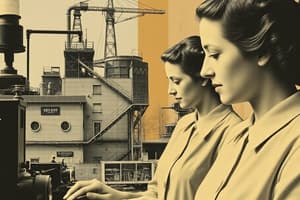Podcast
Questions and Answers
What is the primary characteristic of job shop processes?
What is the primary characteristic of job shop processes?
- They operate continuously in high volumes.
- They produce a limited variety of goods.
- They require a fixed sequence of activities.
- They are organized around general-purpose equipment. (correct)
Which of the following is an example of a flow shop process?
Which of the following is an example of a flow shop process?
- Bespoke tailoring shop
- Automated car wash (correct)
- Custom furniture manufacturing
- Specialty food processing
What distinguishes continuous flow processes from other types?
What distinguishes continuous flow processes from other types?
- They use highly specialized automated equipment. (correct)
- They produce goods in small batches.
- They focus on customization for individual customers.
- They operate with flexible equipment.
During which phase of the product life cycle is a job shop process likely to be utilized?
During which phase of the product life cycle is a job shop process likely to be utilized?
Why is understanding product life cycles important for businesses?
Why is understanding product life cycles important for businesses?
What type of process is typically used for high-volume standard goods?
What type of process is typically used for high-volume standard goods?
As a product matures in its life cycle, what change might occur in its production process?
As a product matures in its life cycle, what change might occur in its production process?
Which characteristic is NOT associated with flow shop processes?
Which characteristic is NOT associated with flow shop processes?
What is the primary purpose of the product-process matrix?
What is the primary purpose of the product-process matrix?
What happens as firms move down the diagonal of the product-process matrix?
What happens as firms move down the diagonal of the product-process matrix?
Why might a company choose to position itself off the diagonal of the product-process matrix?
Why might a company choose to position itself off the diagonal of the product-process matrix?
What risk does a company face when it positions too far off the diagonal of the product-process matrix?
What risk does a company face when it positions too far off the diagonal of the product-process matrix?
Which of the following is an example of a company that employs a job shop process?
Which of the following is an example of a company that employs a job shop process?
What technological advancement has challenged the theory of the product-process matrix?
What technological advancement has challenged the theory of the product-process matrix?
What is a potential outcome of implementing mass-customization strategies?
What is a potential outcome of implementing mass-customization strategies?
What should firms ensure if they choose an off-diagonal positioning strategy?
What should firms ensure if they choose an off-diagonal positioning strategy?
What does the service-positioning matrix aim to address regarding service businesses?
What does the service-positioning matrix aim to address regarding service businesses?
Which type of service allows customers to select from a wide variety of pathways?
Which type of service allows customers to select from a wide variety of pathways?
In which scenario does the service delivery system constrain customer choices?
In which scenario does the service delivery system constrain customer choices?
What are pathways in a service delivery system primarily used for?
What are pathways in a service delivery system primarily used for?
What is a key component of designing customer-routed services?
What is a key component of designing customer-routed services?
Which of the following is NOT an example of a customer-routed service?
Which of the following is NOT an example of a customer-routed service?
The service-positioning matrix focuses on which level of service?
The service-positioning matrix focuses on which level of service?
What aspect does the service-positioning matrix primarily help management with?
What aspect does the service-positioning matrix primarily help management with?
What is the primary goal of reengineering in business processes?
What is the primary goal of reengineering in business processes?
Which question is NOT typically evaluated during process analysis?
Which question is NOT typically evaluated during process analysis?
What is utilization in the context of a business process?
What is utilization in the context of a business process?
Which of the following is a relevant question when considering potential bottlenecks in a process?
Which of the following is a relevant question when considering potential bottlenecks in a process?
What does the term 'process fail points' refer to?
What does the term 'process fail points' refer to?
What is one effect of having idle resources in a process?
What is one effect of having idle resources in a process?
What is a common utilization percentage range found in most job shops?
What is a common utilization percentage range found in most job shops?
Which aspect is essential to evaluate in order to enhance operational performance?
Which aspect is essential to evaluate in order to enhance operational performance?
What factors influence the service-encounter activity sequence?
What factors influence the service-encounter activity sequence?
How does a high degree of repeatability affect service systems?
How does a high degree of repeatability affect service systems?
What does the vertical axis of the Service Positioning Matrix (SPM) represent?
What does the vertical axis of the Service Positioning Matrix (SPM) represent?
What is the potential outcome of moving too far off the diagonal in the SPM?
What is the potential outcome of moving too far off the diagonal in the SPM?
What relationship does the Service Positioning Matrix (SPM) share with the product-process matrix?
What relationship does the Service Positioning Matrix (SPM) share with the product-process matrix?
What typically results from a low degree of repeatability in service encounters?
What typically results from a low degree of repeatability in service encounters?
What does a service encounter that is less unique imply about the service design?
What does a service encounter that is less unique imply about the service design?
What is a consequence of providing customers the opportunity to design their own service-encounter activity sequence?
What is a consequence of providing customers the opportunity to design their own service-encounter activity sequence?
Flashcards are hidden until you start studying
Study Notes
Job Shop Processes
- Flexible and adaptable to produce a wide range of goods and services in small quantities.
- Often used for custom or option-type products.
- Customer orders are processed in batches, with varying sequences of processing steps and movement to different work areas.
Flow Shop Processes
- Organized around a fixed sequence of activities and process steps.
- Produce a limited variety of similar goods or services (e.g., assembly line).
- Used for high-volume, option-oriented, and standard goods and services (e.g., automobiles, appliances, insurance policies).
- Employ specialized equipment and computer software.
Continuous Flow Processes
- Highly standardized goods or services are produced in very high volumes.
- Examples include automated car washes, steel mills, and electronic services like credit card authorizations.
- Rigid sequence of work tasks with specialized, automated equipment, often computer-controlled.
Product Life Cycle (PLC)
- Characterizes the growth, maturity, and decline of a product over time.
- Four phases: introduction, growth, maturity, and decline.
- PLC impacts process design and choice.
Product-Process Matrix
- Aligns process choice with the characteristics of the manufactured good.
- Diagonal alignment represents the ideal match between product type and process type.
- Companies can differentiate themselves by positioning off the diagonal (e.g., Rolls-Royce).
- Advanced manufacturing technologies allow for flexibility and off-diagonal positioning, enabling mass customization strategies.
Service-Positioning Matrix (SPM)
- Addresses limitations of the product-process matrix in service businesses.
- Focuses on the service-encounter level.
- Pathways: customer-driven (broad freedom) or provider-driven (limited options).
- Customer-routed services offer many possible pathways, giving customers control, while provider-routed services restrict options.
- SPM emphasizes the relationship between service-encounter activity sequence and the number of pathways.
Process Analysis
- Evaluates process logic, value-add, efficiency, capacity, skills, and potential errors.
- Identifies opportunities for improvement through elimination, combination, reordering, automation, and performance measurement.
- Emphasizes customer interaction and sustainability.
Reengineering
- Fundamental redesign of business processes for significant performance improvement.
- Involves questioning existing procedures and assumptions for potential radical change.
Resource Utilization
- Measures the fraction of time a workstation or individual is busy.
- 100% utilization is difficult to achieve, typically ranging from 65% to 90% in job shops.
Studying That Suits You
Use AI to generate personalized quizzes and flashcards to suit your learning preferences.





